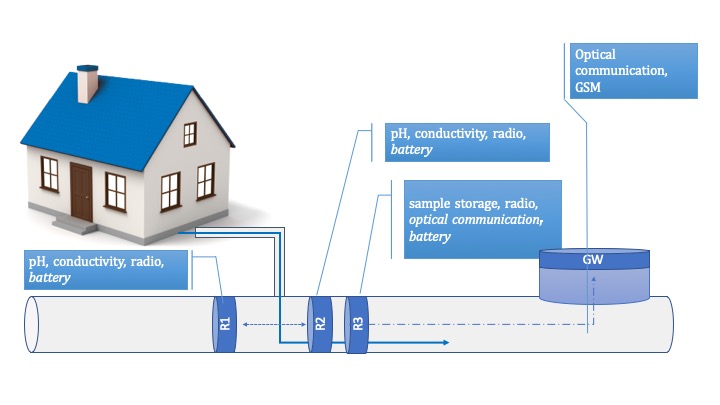Low-power Remote Monitoring
During its 42 months, the consortium managed to fully integrate and test a prototype consisting of three rings, a gateway and a crawler robot. The first two rings contain a pH sensor and a conductivity sensor, while the third ring contains a sampling module and an optical communications module for allowing data transmission to a gateway device installed far away. All rings are equipped, in addition, with an energy management module, additional batteries (in place of the energy harvesting module), a main controller and a radio module.
The micromole system is able to periodically measure pH and conductivity of the sewage flow and to trigger the sampling module for physical evidence gathering, whenever the pH and conductivity measurements abruptly change as to match values that can be correlated with an ATS waste spill in the sewage.
Range of communication in the sewage
Wireless transmission in the sewage environment can be attenuated rapidly due to water steam, sediments in the water and the surrounding materials (pipe and earth metals). The challenge is to find proper means of radio communications in such situations.
We have tested radio communications in the sewage achieving no more than 15 meters of communications using a commercial radio, where in normal conditions it can achieve a range of 200 meters above ground.
Since it is not possible to increase radio power, we focus on designing different customized radio modulations and evaluate radio transmission at different radio frequencies, in order to provide more robust radio channels, increase radio sensitivity and the transmission range.
Consumed energy for wireless transmissions
Traditional mechanisms for reducing energy consumption due to wireless transmission imply scheduling of time-slots transmissions. Micromole uses 802.15.4-TSCH for this aim. A radio transmitter and received agree on a precise time-slot where a transmission will take place. Outside of this time-slot, both transmitter and receiver are in sleep modes. In order to keep synchronization, it is desirable to have a clock which does not drift, and mechanism to detect and compensate for clock drifts across several devices. Detection of clock drifts is usually achieved thanks to the transmission of beacon frames. Micromole developed new time-synchronization algorithms for low-power nodes. Publication is cooming soon.
Transmitted data
BTEC designed new algorithms for data compression that can run efficiently using the low-power controller ARM Cortex-M4F of the main board. A publication will be submitted in summer 2019.
Autonomous and also remote control
Given the low data-rate needed for the application and the need of preserving energy, we design our solution based on 6LoWPAN. Remote management of resources can be achieved using the CoAP protocol, which can work on top of 6LoWPAN/UDP.
By the end of the first period, BTEC and WUT had already a prototype of the communication subsystem (based on CoAP/6LoWPAN) working on the low-power microcontrollers of the ring devices.
